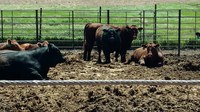NDSU Extension Offers Management Considerations for Delaying Cattle Marketing
(Click the image below to view a high-resolution image that can be downloaded)
The livestock industry faces challenging times during the coronavirus pandemic.
“When packing plants can’t schedule a slaughter date, producers are challenged on how to manage delaying the marketing of their cattle,” says Karl Hoppe, Extension livestock systems specialist at North Dakota State University’s Carrington Research Extension Center.
The most urgent class of cattle to manage are fed slaughter cattle. When maintained on the current ration, these cattle will continue to grow and increase fat deposition. This will lead to heavier carcass weights and higher marbling scores that increase the value per head. However, overweight and/or overly fat carcasses (yield grade 4 and 5) will lead to discounted pricing.
During the last weeks of feeding cattle to finish, cattle increase the amount of fat on their body, resulting in poorer feed efficiency and higher cost of gain, according to Hoppe.
“From a feed efficiency and cost of gain perspective, delaying timely marketing of cattle is not cost effective,” he says.
If cattle are several months away from harvest, decreasing the energy content of the ration and reducing gain is an option. This can be done by increasing the roughage in the ration from 5% to 7% to 10% to 15%. If roughage is unavailable, limiting feeding is an option when adequate bunk space is available.
“Producers need to pay particular attention to feed delivery to match gain goals with feed provided,” Hoppe says. “It’s easy to overfeed or underfeed when limit feeding if cattle weights are not accurately identified and feed delivery adjusted accordingly.”
The classic approach to delaying marketing of cattle is putting the cattle on pasture. Making calves into yearlings by moderating winter growth and running them on grass during the summer puts these yearlings into a different marketing period.
This is accomplished easily with lighter weight cattle but not practical for cattle that have been fed for 3 or more pounds of average daily gain. The cost of gain needs to be considered and compared with the market price from delayed marketing.
Heifers exposed for breeding usually are bred artificially with timed breeding. In combination with a short breeding period and when pregnancy checked via ultrasound, the nonpregnant heifers can be sold to feedlots at an earlier date. Breeding heifers delays marketing by selling open heifer in late summer or bred heifers in the fall or winter.
Don’t use high-potency implants if the energy of the feed ration has been decreased (to delay marketing) because carcass marbling may be affected negatively. Either don’t reimplant or match implant potency and duration to the delayed marketing time.
“Delaying the marketing of finished (fat) cattle has profound impacts on subsequent carcass characteristics and may not be cost effective,” Hoppe says. “Delaying marketing of lighter weight cattle by either pasturing or backgrounding is routinely done with the goal of higher prices for cattle that are seasonally in less supply.”
NDSU Agriculture Communication - June 5, 2020
| Source: | Karl Hoppe, 701-652-2951, karl.hoppe@ndsu.edu |
|---|---|
| Editor: | Ellen Crawford, 701-231-5391, ellen,crawford@ndsu.edu |


